One score plus one year ago, to wit, July 4, 1946, Borrowdale, “the smallest bookshop in the world,” opened its doors to the public in Edgartown. It was then, and is still today, the only shop on the Vineyard devoted solely to the purveyance of literature without resort to the lure of coupons or kickapoo juice or the like. Established by the late Gerald and Margaret Chittenden shortly before his retirement from the faculty of St. Paul’s School, Concord, N.H., Borrowdale quickly became known as the place you could purchase good books immediately, and order the other kind. It is today run by their daughter, Miss Julie C. Chittenden, along the same general lines.
Mr. Chittenden it was who boasted that he was proprietor of the smallest bookshelf in the world. And with some justification, for the building, originally a sort of utility-cum-facilities shed, measured twelve by fifteen feet and was open to the rafters. This was subsequently enlarged by addition of a bow window and an office ell, and winterized to the extent of a proper ceiling. Just like the front door is a plank on which a former owner kept careful track of Civil War battles, together with such personal notations as “Frank left for the War, as a volunteer Sept. 18, 1862.”
The name Borrowdale is a family one, early spelled Borodill, and derives from an Irish ancestor who nursed back to health a Cromwellian soldier; then married him. The couple migrated to what is now the town of Royalton, Vt., where Lady Ann’s good works are part of the local annals.
In The Vineyard Style
The name first designated the adjacent Chittenden home, a century-old example of a style of classic revival architecture which the late Carroll L. V. Meeks of Yale regarded so distinctly Vineyard that he felt it should be thus known, just as an older type is labelled Cape Cod. It was built before 1858, possibly by Samuel G. Vincent, housewright who purchased the house lot from Ellis Lewis in 1851, or by Lewis himself, a well-known carpenter who had worked on many of the fine Edgartown houses and lived on School street. Lewis bought the property from Peter Pease in 1836, and the street - now called Oliver after Oliver Norton, who owned the land at its head - was laid out in 1838.
The Chittendens acquired the property from Frank H. Marchant in 1924, and after twenty-three years as members of the Edgartown summer colony decided to experiment with a bookshop - an experiment Mr. Chittenden was eminently qualified to conduct in view of his forty-odd years of teaching English literature. Naturally with his scholastic background, which included a degree from Yale, his taste in books was selective, and he flattered his customers by assuming their tastes were similar. What these latter tastes actually were may be documented by entries in the Borrodale Day books.
Bestseller on the fiction list for 1947 was Henry Bettle Hough’s romantic novel of New Bedford’s whaling era, Lost Anchorage, which, incidentally, sold for $3. Runner-up also at $3, was The Moneyman, one of Thomas B. Costain’s earlier and more successful historical works based on the life of Jacques Coeur, famed French financier of the fifteenth century. Logbook for Grace by Robert Cushman Murphy shared nonfiction popularity with John Gunther’s Inside U.S.A., reflecting the Vineyard readers’ interest in rousing sea stories as well as current events. And Field Guide to the birds, then $3.75, became established as a perennial item.
Another by Rachel Carson
The year 1952 saw Rachel Carson following up The Sea Around Us with another best seller, Under the Sea Wind, a natural history of seashore life. Elizabeth Vining’s account of her experiences as governess in the Japanese royal family, Windows for the Crown Prince, was next on the notification list, while Island Summer by Walter Teller, published the previous year was still in demand. The Houses in Between, a solid English novel in the classic tradition from the pen of Howard Spring was an outstanding favorite and deservedly so. Early runner-up for fiction was the warmly humorous Don Camillo and his Flock by Guardeschi, but second place was taken over in midsummer with the publication of Steinbeck’s panoramic novel of a century of American life, East of Eden.
Five years later a romantic novel once again led the fiction sales, The Scapegoat by Daphne du Maurier. Among the also-rans was John Cheever’s The Wapshot Chronicle, a literate and wry story of New England family and village life. The same setting but with different adjectives would describe Peyton Place, which sold well on special order, but was not carried in stick. Not that the Chittendens were a self-constituted Watch and Ward Society; merely that they considered pornography dull reading.
Guns of Navarone, an early suspense novel by Alistair McLean, and Rose Macauley’s gentle ironic Turkish travel tale, The Towers of Trebizond, also found a ready market among Borrowdale clientele this year of 1957. Preference in nonfiction was for either of Sheep and Men, an enchanting saga of the Scottish lowlands by R. G. Robertson, or The Short Reign of Pippen IV, Steinbeck’s gem of political satire.
By Love Possessed was a midsummer publication by “name author” James Cozzens, ensuring it special notice. This was one of the first “page 57” books as they came to be known to the Oliver Street Regulars, signifying a whole genus of novels whose first seduction scene occurred on or near that page.
Prices Turned Upward
Prices in 1957 had begun to rise, though not as sharply as more recently. Fiction ranged from $3.50 to $5, and the same for nonfiction. Today, save for “penny dreadfuls,” they begin at $5 and keep going, always up. Bird Guides, for example, no cost $4.95.
Biography was the 1962 first choice at Borrowdale, namely the Rothschilds by Frederic Morton, which sold and sold and sold! John Steinbeck’s Travels with Charley, that unforgettable account of a cross-country trek with a dog, placed second in the roaster of nonfiction. Several novels of widely varied subject matter vied for first in fiction.
These were Anne Morrow Lindbergh’s thoughtful book about marriage and its variances, Dearly Beloved; Capt. Newman M. D. by Leo Rosten, its title self-descriptive; Ship of Fools, the long awaited behemoth by Katharine Anne Porter; and The Satan Bug, another tantilizer by Alistair McLean.
This year it is too soon even to predict what will whet the Vineyard reading appetite, as the season is only just upon us. That Quail, Robert was an early favorite, and at the moment Harold Nicholson’s Diaries, vols. I and II, are “hot.” Three novels by adopted Vineyard sons have come out in recent months: Under the Eye of the Storm by John Hersey; The Tour of David Ely; and The Eight Day by Thornton Wilder. Aug. 1 should see the publication of Season Within, a book of poems by the Vineyard’s talented poetress, Marion Lineaweaver. Miss Chittenden, herself, like Oranges, a botany and history of the fruit. And it may be of interest to note that the Tale of Peter Rabbit continues to attract readers.
All-Time Best Seller
The all-time bestseller at Borrowdale has been Rachel Carson’s The Sea Around Us, published in 1951, and steady sellers include Country Editor, Born Free, These Fragile Outposts, Madami and Of Sheep and Men; these plus books dealing with Vineyard history and lore, especially when by Vineyard authors.
Some of these Vineyard authors will be helping celebrate Borrowdale Bookshop’s 21st birthday along with Miss Chittenden and her staff at an open house Friday, July 7, from 4 to 6, to which friends and booklovers are cordially invited.




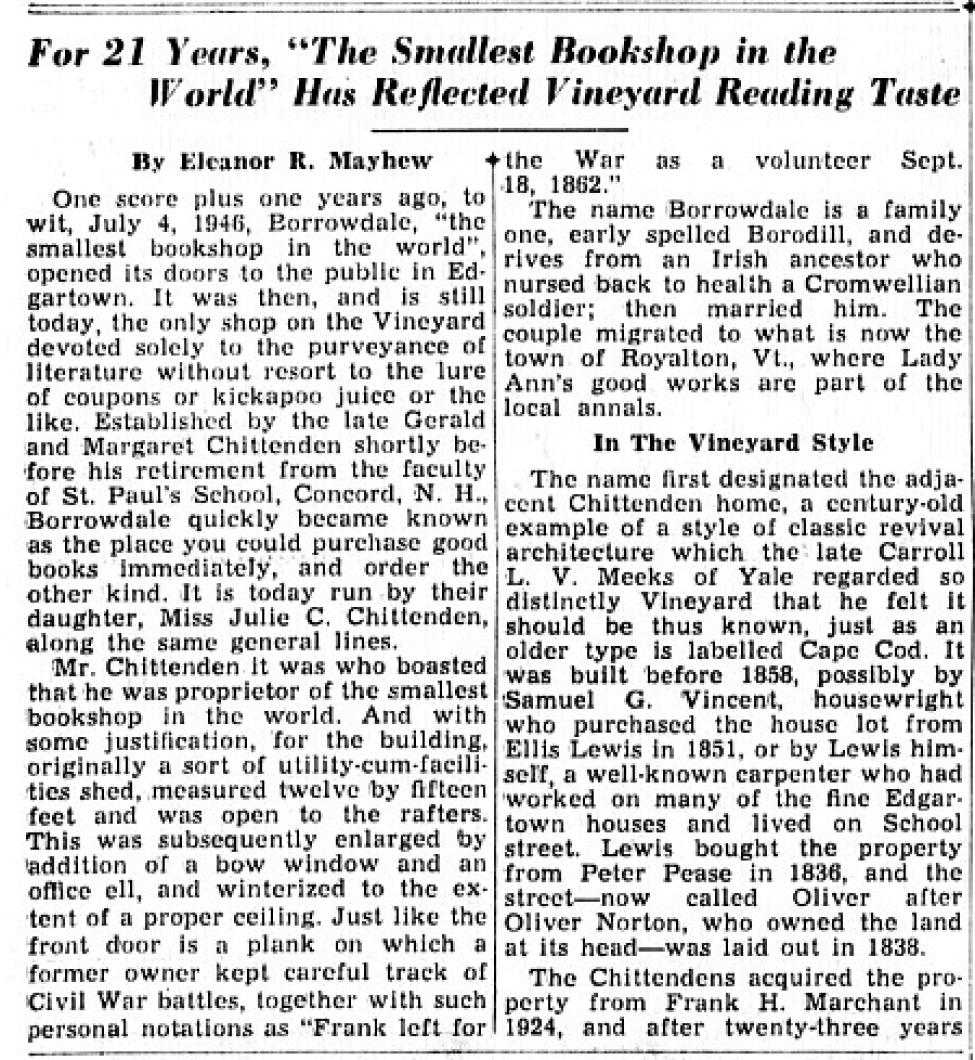
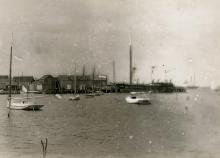
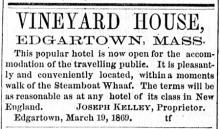
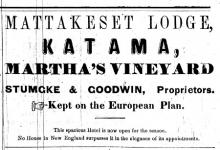
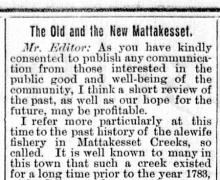

Comments